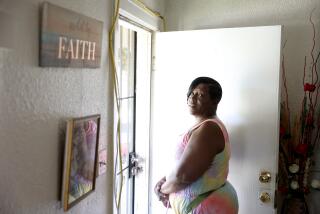Bend Foster Care Rules So Families Don’t Break
Consider a typical child welfare scenario: A 4-year-old boy, a single mom and drug abuse. The boy is like 4-year-olds everywhere -- lively, engaged and happy most of the time. His mom loves him very much. But she uses drugs and sometimes neglects her son. She forgets to come home on time and, on occasion, she takes her anger out on her child.
In Los Angeles County today, child welfare officials have little choice but to break up such a family, placing the child with strangers in an overburdened foster care system where kids can languish for years. Once in foster care, he’s likely to pass through as many as four foster homes and nine schools. As he grows older, the results speak for themselves: 40% of the kids who “age out” of our foster care system (at 18 or sometimes older) end up on public assistance; 25% become homeless; and an astonishing one in five ends up incarcerated.
But this shouldn’t be the only choice. Child welfare officials should be able to offer the kind of social services that could give troubled but still-functioning families a fighting chance to stay together. In the case given above, a substance abuse program, anger management and parenting training may be all that is required to keep a 4-year-old out of a broken foster care system and set his mom on a sustainable and productive path.
Last month, the Los Angeles County Board of Supervisors took a giant step forward along such a path by authorizing the county’s Department of Children and Family Services to submit a waiver application (through the state) to the U.S. Department of Health and Human Services. If approved, this waiver will permit the county to spend federal child welfare funds not just on youngsters taken into foster care -- as current funding rules all but require -- but also on a wide variety of early intervention, prevention and crisis services aimed at helping families through hard times. The state and the federal government must act before a March 31 deadline or the waiver application and the opportunity to innovate will be at risk.
Can we be sure making such a change in the way we handle troubled families will work? Illinois is a case in point. Under waiver authority, Illinois dramatically reduced the number of children in its foster care system, from 51,000 to 19,000 over five years. Social worker caseloads consequently dropped dramatically -- to 14 to 18 cases from 45 to 60 cases -- enabling those on the front lines to focus on the children and families most in need.
Waiver successes have played out in other states as well: Delaware used a waiver to help parents overcome addiction, reducing by nearly one-third the average time that children of drug- and alcohol-abusing parents spent in foster care; Maryland used waiver-based innovations to move more than 300 children from foster care limbo to permanent homes; and Connecticut used the waiver process to develop intensive mental health services, reducing the duration and number of youngsters in highly restrictive settings and helping kids return home quickly.
Los Angeles County -- which has about 30,000 kids in foster care and is home to an astounding one in 10 foster children nationwide -- will always have to rely on foster care to deal with certain cases of abuse and neglect. But continuing the foster care status quo in our county is unacceptable. Increased flexibility in how the county uses federal dollars would recognize that a “one size fits all” approach doesn’t work and would allow us to address the failures of the current system.
“The moral test of a society is how that society treats those who are in the dawn of life, its children,” said onetime Vice President Hubert Humphrey. Los Angeles County has taken a critical first step in improving the way it treats children and families. Now it is time for the state and federal governments to keep that momentum going. For the sake of thousands of abused and neglected children, we cannot afford to fail.
*
Miriam Aroni Krinsky is executive director of the Children’s Law Center of Los Angeles. Jess McDonald is the co-director of Fostering Results, a national foster care awareness project.
More to Read
Sign up for Essential California
The most important California stories and recommendations in your inbox every morning.
You may occasionally receive promotional content from the Los Angeles Times.










